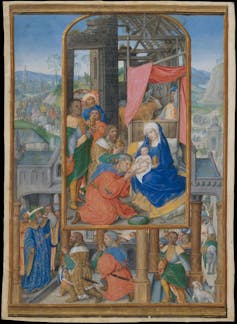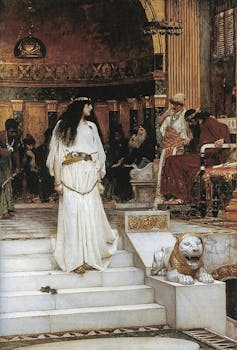ARTICLE AD BOX

King Herod will sound familiar to anyone who’s heard the Christmas story. King of Judea when Jesus of Nazareth was born, the ruler attempts to find and kill the baby after hearing that the “King of the Jews” has just been born.
Tricked by the Magi, the wise men whom Herod had sent to determine where the infant was, a raging Herod decreed that all children 2 and under who live near Bethlehem are to be killed. The Gospel of Matthew contains the famous account of this “slaughter of the innocents,” and of Mary, Joseph and Jesus’ flight to Egypt.
Interestingly, King Herod’s storyline is not found in any other biblical texts nor in Roman records. Yet it is pivotal in Matthew’s Gospel, which contrasts Herod’s mission, death, to that of the baby Jesus, life.
So who was the real King Herod – and why would Matthew’s Gospel include him?
I am a scholar who studies the interpretation of Matthew’s Gospel, as well as the Jewish roots of Christianity. Historians in the field know a fair amount about Herod’s life, and the actual facts are somewhat surprising.
‘King of the Jews’
Writers such as the Jewish historian Josephus, who fought against Roman rule in the first century C.E. before eventually allying himself with Rome, have provided detailed accounts regarding Herod’s deeds. In addition, modern archaeologists have excavated many sites associated with him, including the possible location of Herod’s tomb.
A manuscript illumination of the Magi visiting Jesus, made in the Netherlands in the 16th century, shows the Magi before Herod at the bottom of the image.
Sepia Times/Universal Images Group via Getty Images
According to historical accounts, Herod the Great was the regional king of Judea, which contained the cities of Bethlehem and Jerusalem. He ruled from about 37 B.C.E. until his death in 4 B.C.E., at a time when Judea was still under Roman influence. Most scholars estimate that Jesus was born between 6 and 4 B.C.E. – during Herod’s reign, as Matthew’s Gospel indicates.
Since Herod was appointed by Rome to rule over Judea, a mostly Jewish region, he was literally “king of the Jews.” However, Herod may not have actually been Jewish at all, at least by birth.
He was likely from the region known as Idumea, to the south. Herod’s father had likely been forced to convert to Judaism, as scholars believe many Idumeans were, while his mother was an Arabian princess. However, as Josephus points out, the two groups intermingled quite extensively, with some Idumeans, perhaps including his father, willingly adopting Jewish customs.
Josephus even declares that Herod was basically a Judean, though it is likely that many of the native Jews in Judea would have been skeptical of their king’s claims to be truly Jewish and viewed him as an outsider, especially if he did come from Idumea. However, Josephus does indicate that Herod would ally himself with Roman leadership whenever he deemed it prudent.
‘Great’ but severe
Herod the Great proved himself a skillful builder, responsible for the planning and construction of projects such as the city of Herodium; the extravagant harbor at Caesarea Maritima, on the Mediterranean Coast; and the mountain fortress of Masada, which was located in the middle of the unforgiving desert near the Dead Sea.
Most famously, perhaps, was Herod’s rebuilding and expansion of the Jewish temple complex in Jerusalem. This project alone took decades to complete. Herod’s remodeled temple was a much more grandiose structure than Solomon’s original temple, built about a thousand years earlier. Josephus noted how it resembled a white, snow-covered mountain – that is, the parts of it that were not covered in gold.
Jewish men pray at the Western Wall in Jerusalem, part of Herod’s expansion of the temple complex.
Israel Fuguemann/SOPA Images/LightRocket via Getty Images
Regardless of whether Herod was actually Jewish, he contributed to the preservation of Judaism. He succeeded in exempting Jews from serving in the Roman military and having to engage in emperor worship, preserving their ability to practice Judaism in relative peace.
Herod also proved himself a brilliant economic strategist who greatly increased the wealth of Judea by engaging in ventures such as international trade, which included the sale of balsam wood and copper. He contributed funds to national and international endeavors, including the Olympic Games, and it is said that he even averted a regional famine.
Yet Herod’s sinister reputation as a tyrant was probably well deserved.
Herod sentenced his own wife to death, suspecting her of plotting to kill him: ‘Mariamne Leaving the Judgement Seat of Herod,’ by painter John William Waterhouse.
Because he constantly feared a rebellion, he would execute anyone he deemed a threat to his reign, including his own first wife and three of his sons. In addition, he was reported to have excessively taxed his constituents to help support his economic programs.
Similar stories?
There is no historical record of any “massacre of the innocents” – even the tyrannical Herod most likely never condoned such an action.
If that was the case, why does Matthew’s Gospel mention King Herod so prominently in Jesus’ birth narrative?
Matthew’s version is considered the most Jewish of the Gospels, the four biblical accounts of Jesus’ life in the New Testament – for example, it advocates for upholding Jewish laws. In other words, Matthew’s Gospel was likely written by Jews for a mostly Jewish audience late in the first century C.E., when the Christian movement was still in its infancy.
Matthew’s audience would have been familiar with the existing Hebrew scriptures, including the famous story of Moses’ childhood, when he escapes the pharaoh’s edict to kill all the newborn sons of his Hebrew slaves. Biblical scholars have made the case that Matthew’s Gospel intentionally compared Jesus with Moses, who saved the Hebrews from Egyptian bondage, to convince the intended audience that Jesus, too, was a long-awaited savior.
To strengthen the similarities between Jesus and Moses, this argument goes, the authors of Matthew had Herod threaten Jesus in the same manner that the pharaoh threatened the Hebrew children. The Jewish audience of Matthew would have connected the two narratives, in which good ultimately triumphs over evil. The Gospel story further villainizes Herod, whose son, also called King Herod, or Herod Antipas, was ruling at the time of Jesus’ crucifixion around 30 C.E.
Herod may have been a splendid builder and a savvy economist – and technically the “King of the Jews.” But in the eyes of the Gospel authors, it was Jesus who truly deserved that title.![]()
Aaron Gale, Associate Professor of Religious Studies, West Virginia University
This article is republished from The Conversation under a Creative Commons license. Read the original article.
.png)
 1 year ago
20
1 year ago
20











 English (US)
English (US)